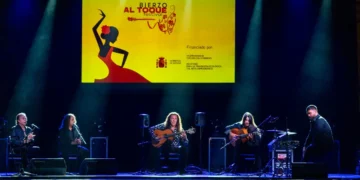|
|
||||||||||||
|
SPECIAL COVERAGE: BIENAL DE FLAMENCO DE SEVILLA 2010 «Luz de Guía» (el destello eterno) TOMATITO Guitar: Tomatito; Second guitar: Cristi; Voices: Antonio Ingueta, Simón Román, Morenito de Íllora; Double bass: Maca; Percussion: Lucky Losada, Moisés Santiago; Dance: José Maya. Text: Gonzalo Montaño Peña. Almería guitarist Tomatito came to the Bienal to pay tribute to the person who has long been his main musical reference: Camarón de la Isla. Both the music and the verses sung were in reference to the singer. There were also moments in which he took a slight break from flamenco to slip into South American sounds. The concert opened with taranta, a style from the Levante area where José Fernández finds a different sound, one in which he leaves the mark of his own personality. This serves as his calling card, although nearly everyone knew what they were coming to hear, and that’s just what it was: the Tomate Sound, voices that imitate Camarón’s scales, impossibly high registers and the incessant compás of bulerías and tangos. When the guitarist gets into the rhythmic styles, he’s a cyclone. Technique-wise, we’re accustomed to seeing much greater displays of virtuosity, but he has a kind of swing in the compás that brings the best out of the six strings. Towards the middle of the recital, we got much more melodic compositions, in minor mode and with a Brazilian feeling. Here Tomatito falls short since he has little original to offer in these styles. Nor was I convinced by his musical flirtation with Buenos Aires and the sound of Argentine tango, which was pretty enough but not what we expect from Tomatito. If we want to hear music from Brazil or Argentina, there are plenty of real specialists like Luis Salina and others. The soleá by contrast was wonderful, though brief. And despite these continuous changes of rhythm…from soleá to tangos to bulerías and back to soleá…it was here he got into the groove. Both the voices and the compositions in the Camarón style sounded out-moded, and I think they waste the tremendous potential and talent of these singers who end up being little more that Camarón impersonators. Also old-fashioned was the concept of having a cajón sound throughout the entire recital, which meant under-use of the great talent of the percussionists, relegating them to a sharp metallic sound, like a tambourine, which occupies too much sound-space. I think a cajón can have it’s place in a show, but to use it straight through is excessive. José Maya’s dancing had its moments – this is a dancer who is very interesting in small doses. He exhibited temperament, strength and a privileged sense of rhythm, his elegant arms responded to the singing in a flamenco way and his soleá was one of the best moments of the entire night. Overall, the concert reached the heights when Tomate sounded the way we were all expecting, when he let his hair down and the compás rip, giving us his most flamenco sound, that sound that makes him who he is and will continue to be as long as he plays guitar. “LAS MINAS DE EGIPTO” – ARGENTINA Text: Estela Zatania Voice: Argentina. Guitar: José Quevedo, Ricardo Rivera. Palmas: Bobote, Torombo. Double bass: Dani Arjona. Brass: Puntas, Julito. Guest artist: Manuel Parrilla. She sang everything, and sang it well. Easy to say, right? Native Americans knew the importance of im-perfection. In their weaving and jewelry, they would include some small “defect”, a single thread or stone of a different color. What I’m getting at is that the biggest problem with Argentina’s perfect recital was the oppressive perfection and lack of risk-taking. Polished technique, clean pure tones, studied compás, exquisitely appropriate gestures for each song, a group of twelve musicians, chorus and palmas, all very well-prepared. Everything impeccable. By the way, “impeccable” means “incapable of sinning”. I think after seeing this recital, I prefer my flamenco artists to be “sinners”. Like the incorrigible dancer Torombo who was one of the palmeros. Between the singer’s abandolao (perfect) and cante of levante (impeccable), he suddenly threw his head back and let rip an imperfect and peccable primal scream of “Argentinaaaa!” that surely was heard at the Isla Mágica theme park just down the black. Some people didn’t know how to react and laughed nervously, while others were delighted with the unseemly outburst from this very flamenco person. Argentina opened with a sure thing, capturing the audience’s interest with the energetic compás of Torombo and Bobote, and the guitars of José Quevedo “Bola” and Ricardo Rivera for a medley of Paquera’s songs. Beautiful designer lighting set the mood for nanas before the above-mentioned abandolao. For mining cante, the image of a mine shaft was projected onto the backdrop. Here, the singer’s sweet delivery was perfect, and the audience fell in love with her. Granaína was more of the same. Then, Jerez guitarist Manuel Parrilla joined the group to invoke the specific duendes for bulería por soleá in the style of his hometown, and Argentina included the unusual style (I don’t remember coming across any other in soleá that demands G minor (?)) that provides the title for her second recording, and this recital of presentation. “Las Minas de Egipto” is attributed to Rosalía de Triana or Chacha María Peña, depending on whom you ask. In siguiriyas, the sweetness ified the intensity normally associated with this form, but in alegrías, composed by Ricardo Rivera with the silky chorus of the Mellis (if you remember when alegrías had no composers or choruses, you’re over fifty), the backup raises enough excitement to give a flamenco sound. After Quevedo’s guitar solo, Argentina returns in a different dress to open the more upbeat portion of the program. A trumpet and a trombone scream out, the lighting takes on the look of a Caribbean night-club, the smoke machine goes into high gear and a chorus is repeated umpteem times. At this point, the audience cooled down a bit, but Argentine rescued the situation in the nick of time with an exotic selection of fandangos de Huelva. With nearly overwhelming energy coming from the backup, we get back to bulerías, now with Utrera repertoire, to round out the two-hour-long recital. “NOCHE DE EXTREMADURA. FLAMENCO” Text: Estela Zatania First part. Cante: Miguel de Tena, Esther Merino, Pedro Peralta, Raquel Cantero, Pedro Cintas. Guitar: Francis Pinto, Perico de Paula, Juan Manuel, Joaquín Muñino. Dance: La Parreña. The second part was another story. A tsunami of that unmistakable aroma filled the patio, the street, the Triana night… The tangos that are so familiar to our ears thanks to Camarón who put them in circulation among non-Extremadurans, lots of group choruses with the mysterious sheen that comes from harmonized voices and lots of “ay le le le” insinuating exotica. A slight older man in suit and tie danced with strength, elegance and compás, and you just wanted to pack him up and take him home he’s so good. The audience gets more and more into the groove, and the artists get more inspired. Noteworthy…lots…was one of the voices. That of La Kaíta, whom I hadn’t heard in many years, not since I discovered her singing at a romería in Fregenal, and she’d seemed like an Extremaduran Fernanda de Utrera in the rough, raising gooseflesh with her impossible voice and her ways, and for a while you don’t even know if you’re in the Plaza Alta or Triana’s Altozano. What a tasty alternative dimension to flamenco; too seldom do we have the chance to enjoy it. |
Descubre más desde Revista DeFlamenco.com
Suscríbete y recibe las últimas entradas en tu correo electrónico.







































